Fire extinguisher
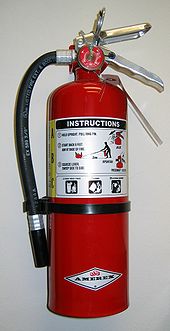
A fire extinguisher is an active fire protection device used to extinguish or control small fires, often in emergency situations. It is not intended for use on an out-of-control fire, such as one which has reached the ceiling, endangers the user (i.e. no escape route, smoke, explosion hazard, etc.), or otherwise requires the expertise of a fire department. Typically, a fire extinguisher consists of a hand-held cylindrical pressure vessel containing an agent which can be discharged to extinguish a fire.
There are two main types of fire extinguishers: stored pressure and cartridge-operated. In stored pressure units, the expellant is stored in the same chamber as the firefighting agent itself. Depending on the agent used, different propellants are used. With dry chemical extinguishers, nitrogen is typically used; water and foam extinguishers typically use air. Stored pressure fire extinguishers are the most common type. Cartridge-operated extinguishers contain the expellant gas in a separate cartridge that is punctured prior to discharge, exposing the propellant to the extinguishing agent. This type is not as common, used primarily in areas such as industrial facilities, where they receive higher-than-average use. They have the advantage of simple and prompt recharge, allowing an operator to discharge the extinguisher, recharge it, and return to the fire in a reasonable amount of time. Unlike stored pressure types, these extinguishers utilize compressed carbon dioxide instead of nitrogen, although nitrogen cartridges are used on low temperature (-60 rated) models. Cartridge operated extinguishers are available in dry chemical and dry powder types in the US and in water, wetting agent, foam, dry chemical (classes ABC and BC),and dry powder (class D) types in the rest of the world.
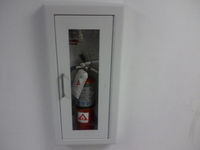
Fire extinguishers are further divided into handheld and cart-mounted, also called wheeled extinguishers. Handheld extinguishers weigh from 0.5 to 14 kilograms (1 to 30 pounds), and are hence, easily portable by hand. Cart-mounted units typically weigh 23+ kilograms (50+ pounds). These wheeled models are most commonly found at construction sites, airport runways, heliports, as well as docks and marinas.
Contents |
History

The first fire extinguisher of which there is any record was patented in England in 1723 by Ambrose Godfrey, a celebrated chemist. It consisted of a cask of fire-extinguishing liquid containing a pewter chamber of gunpowder. This was connected with a system of fuses which were ignited, exploding the gunpowder and scattering the solution. This device was probably used to a limited extent, as Bradley's Weekly Messenger for November 7, 1729, refers to its efficiency in stopping a fire in London.
The modern fire extinguisher was invented by British Captain George William Manby in 1818; it consisted of a copper vessel of 3 gallons (13.6 litres) of pearl ash (potassium carbonate) solution contained within compressed air.
The soda-acid extinguisher was first patented in 1866 by Francois Carlier of France, which mixed a solution of water and sodium bicarbonate with tartaric acid, producing the propellant CO2 gas. A soda-acid extinguisher was patented in the U.S. in 1881 by Almon M. Granger. His extinguisher used the reaction between sodium bicarbonate solution and sulfuric acid to expel pressurized water onto a fire.[1] A vial was suspended in the cylinder containing concentrated sulfuric acid. Depending on the type of extinguisher, the vial of acid could be broken in one of two ways. One used a plunger to break the acid vial, whilst the second released a lead stopple that held the vial closed. Once the acid was mixed with the bicarbonate solution, carbon dioxide gas was expelled and thereby pressurized the water. The pressurized water was forced from the canister through a nozzle or short length of hose.
The cartridge-operated extinguisher was invented by Read & Campbell of England in 1881, which used water or water-based solutions. They later invented a carbon tetrachloride model called the "Petrolex" which was marketed toward automotive use.[2]
The chemical foam extinguisher was invented in 1904 by Aleksandr Loran in Russia, based on his previous invention of fire fighting foam. Loran first used it to extinguish a pan of burning naphtha.[3] It works and looks similar to the soda-acid type, but the inner parts are different. The main tank contains a solution of water, foam compound (usually made from licorice root) and sodium bicarbonate. A cylindrical metal or plastic chamber holds about a quart and a half of 13% aluminium sulfate and is capped with a lead cap. When the unit is turned over, the chemicals mix, producing CO2 gas. The licorice causes some of the CO2 bubbles to become trapped in the liquid and is discharged on the fire as a thick whitish-brown foam.
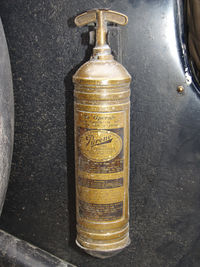
In 1910, The Pyrene Manufacturing Company of Delaware filed a patent for a using carbon tetrachloride (CTC) to extinguish fires.[4] The CTC vaporized and extinguished the flames by creating a dense, oxygen-excluding blanket of fumes, and to a lesser extent, inhibiting the chemical reaction. In 1911, they patented a small, portable extinguisher that used the chemical.[5] This consisted of a brass or chrome container with an integrated handpump, which was used to expel a jet of liquid towards the fire. It was usually of 1 imperial quart (1.1 L) or 1 imperial pint (0.6 L) capacity but was also available in up to 2 imperial gallon (9 L) size. As the container was unpressurized, it could be refilled after use through a filling plug with a fresh supply of CTC.[6]
Another type of carbon-tetrachloride extinguisher was the Fire grenade. This consisted of a glass sphere filled with CTC, that was intended to be hurled at the base of a fire (early ones used salt-water, but CTC was more effective). Carbon tetrachloride was suitable for liquid and electrical fires and the extinguisers were fitted to motor vehicles. Carbon-tetrachloride extinguishers were withdrawn in the 1950s because of the chemical's toxicity–exposure to high concentrations damages the nervous system and internal organs. Additionally, when used on a fire, the heat can convert CTC to Phosgene gas [7], formerly used as a chemical weapon.
In the 1940s, Germany invented the liquid chlorobromomethane (CBM) for use in aircraft. It was more effective and slightly less toxic than carbon tetrachloride and was used until 1969. Methyl bromide was discovered as an extinguishing agent in the 1920s and was used extensively in Europe. It is a low-pressure gas that works by inhibiting the chain reaction of the fire and is the most toxic of the vaporizing liquids, used until the 1960s. The vapor and combustion by-products of all vaporizing liquids were highly toxic, and could cause death in confined spaces.
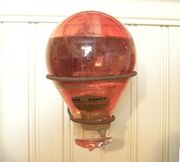
The carbon dioxide (CO2) extinguisher was invented (at least in the US) by the Walter Kidde Company in 1924 in response to Bell Telephone's request for an electrically non-conductive chemical for extinguishing the previously difficult to extinguish fires in telephone switchboards. It consisted of a tall metal cylinder containing 7.5 lbs. of CO2 with a wheel valve and a woven brass, cotton covered hose, with a composite funnel-like horn as a nozzle. CO2 is still popular today as it is an ozone-friendly clean agent and is used heavily in film and television production to extinguish burning stuntmen.[8] Carbon dioxide fire extinguishers must be inspected frequently. Carbon dioxide extinguishes fires in part by rapidly cooling the burning object below its ignition temperature, making it unable to sustain combustion. This characteristic is well known and has led to the widespread misuse of carbon dioxide extinguishers to rapidly cool beverages, especially beer.
In 1928, DuGas (later bought by ANSUL) came out with a cartridge-operated dry chemical extinguisher, which used sodium bicarbonate specially treated with chemicals to render it free-flowing and moisture-resistant. It consisted of a copper cylinder with an internal CO2cartridge. The operator turned a wheel valve on top to puncture the cartridge and squeezed a lever on the valve at the end of the hose to discharge the chemical. This was the first agent available for large scale three-dimensional liquid and pressurized gas fires, and was but remained largely a specialty type until the 1950s, when small dry chemical units were marketed for home use. ABC dry chemical came over from Europe in the 1950s, with Super-K being invented in the early 60s and Purple-K being developed by the US Navy in the late 1960s.
In the 1970s, Halon 1211 came over to the US from Europe, where it had been used since the late 40s or early 50s. Halon 1301 had been developed by DuPont and the US Army in 1954. Both 1211 and 1301 work by inhibiting the chain reaction of the fire, and in the case of Halon 1211, cooling class A fuels as well. Halon is still in use today, but is falling out of favor for many uses due to its environmental impact. North America, Europe, and Australia have severely restricted its use, since the Montreal Protocol of 1987. It is however still in use in the Middle East, and Asia.
Classification
Internationally there are several accepted classification methods for hand-held fire extinguishers. Each classification is useful in fighting fires with a particular group of fuel.
Australia
| Type | Pre-1997 | Current | Suitable for use on Fire Classes (brackets denote sometimes applicable) | ||||||
|---|---|---|---|---|---|---|---|---|---|
| Water | Solid red | Solid red | A | ||||||
| Foam | Solid blue | Red with a blue band | A | B | |||||
| Dry chemical (powder) | Red with a white band | Red with a white band | A | B | C | E | |||
| Carbon dioxide | Red with a black band | Red with a black band | (A) | B | D | F | |||
| Vaporising liquid (not halon) | Red with a yellow band | Red with a yellow band | A | B | C | E | |||
| Halon | Solid green | No longer produced | A | B | E | ||||
| Wet chemical | Solid oatmeal | Red with an oatmeal band | A | F | |||||
In Australia, yellow (Halon) fire extinguishers are illegal to own or use on a fire, unless an essential use exemption has been granted.[9]
United Kingdom

According to the standard BS EN 3, fire extinguishers in the United Kingdom as all throughout Europe are red RAL 3000, and a band or circle of a second color covering between 5-10% of the surface area of the extinguisher indicates the contents. Before 1997, the entire body of the fire extinguisher was color coded according to the type of extinguishing agent.
The UK recognizes six fire classes:
- Class A fires involve organic solids such as paper and wood.
- Class B fires involve flammable or combustible liquids. Gasoline, grease and oil fires are included in this class.
- Class C fires involve flammable gases
- Class D fires involve combustible metals.
- Class E fires involving electrical appilances (no longer used as when the power supply is turned off an electrical fire can fall into any category)
- Class F fires involve cooking fat and oil.
Fire extinguishing performance per fire class is displayed using numbers and letters such as 13A, 55B.
EN3 does not recognize a separate electrical class - however there is an additional feature requiring special testing (35 kV dielectric test per EN 3-7:2004). A powder or CO2 extinguisher will bear an electrical pictogram as standard signifying that it can be used on live electrical fires (given the symbol E in the table). If a water-based extinguisher has passed the 35 kV test it will also bear the same electrical pictogram - however, any water-based extinguisher is only recommended for inadvertent use on electrical fires.
| Type | Old code | BS EN 3 colour code | Suitable for use on fire classes (brackets denote sometimes applicable)[11] |
||||||
|---|---|---|---|---|---|---|---|---|---|
| Water | Signal red | Signal red | A | ||||||
| Foam | Cream | Red with a cream panel above the operating instructions | A | B | |||||
| Dry powder | Blue | Red with a blue panel above the operating instructions | (A) | B | C | E | |||
| Carbon dioxide CO2 | Black | Red with a black panel above the operating instructions | B | E | |||||
| Wet chemical | N/A | Red with a canary yellow panel above the operating instructions | A | (B) | F | ||||
| Class D powder | Blue | Red with a blue panel above the operating instructions | D | ||||||
| Halon gas | Green | Now prohibited except under certain situations.[11] | |||||||
In the UK the use of Halon gas is now prohibited except under certain situations such as on aircraft and in the military.[11]
United States
There is no official standard in the United States for the color of fire extinguishers, though they are typically red, except for Class D extinguishers, which are usually yellow, and water, which are usually silver, or white if water mist. Extinguishers are marked with pictograms depicting the types of fires that the extinguisher is approved to fight. In the past, extinguishers were marked with colored geometric symbols, and some extinguishers still use both symbols. The types of fires and additional standards are described in NFPA 10: Standard for Portable Fire Extinguishers, 2007 edition.
| Fire Class | Geometric Symbol | Pictogram | Intended Use | |
|---|---|---|---|---|
| A | Green Triangle | Garbage can and wood pile burning | Ordinary solid combustibles | |
| B | Red Square | Fuel container and burning puddle | Flammable liquids and gases | |
| C | Blue Circle | Electric plug and burning outlet | Energized electrical equipment | |
| D | Yellow Decagon (Star) | Burning Gear and Bearing | Combustible metals | |
| K | Black Hexagon | Pan burning | Cooking oils and fats |
The Underwriters Laboratories rate fire extinguishing capacity in accordance with UL/ANSI 711: Rating and Fire Testing of Fire Extinguishers. The ratings are described using numbers preceding the class letter, such as 1-A:10-B:C. The number preceding the A multiplied by 1.25 gives the equivalent extinguishing capability in gallons of water. The number preceding the B indicates the size of fire in square feet that an ordinary user should be able to extinguish. There is no additional rating for class C, as it only indicates that the extinguishing agent will not conduct electricity, and an extinguisher will never have a rating of just C.
- For additional US UL rating information see Fast Flow Extinguishers
Installation
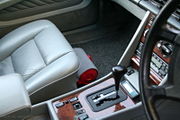
Fire extinguishers are typically fitted in buildings at an easily-accessible location, such as against a wall in a high-traffic area. They are also often fitted to motor vehicles, watercraft, and aircraft - this is required by law in many jurisdictions, for identified classes of vehicles. Under NFPA 10 all commercial vehicles must carry at least one fire extinguisher (size/UL rating depending on type of vehicle and cargo (i.e.. fuel tankers typically must have a 9.1 kg (20 lb). when most others can carry a 2.3 kg (5 lb).) The revised NFPA 10 created criteria on the placement of "Fast Flow Extinguishers" in locations such as those storing and transporting pressurized flammable liquids and pressurized flammable gas or areas with possibility of three dimensional class B hazards are required to have "fast flow" extinguishers as required by NFPA 5.5.1.1. Varying classes of competition vehicles require fire extinguishing systems, the simplest requirements being a 1A:10BC hand-held portable extinguisher mounted to the interior of the vehicle.
Types of extinguishing agents
Dry chemical
 A small, disposable sodium bicarbonate dry chemical unit intended for home kitchen use. |
 A typical dry chemical extinguisher containing 5 lbs. of ammonium phosphate dry chemical. |
 A 20lb.U.S.Navy cartridge-operated purple-K dry chemical (potassium bicarbonate) extinguisher. |
Two Super-K (potassium chloride) extinguishers. |
Powder based agent that extinguishes by separating the four parts of the fire tetrahedron. It prevents the chemical reaction between heat, fuel and oxygen and halts the production of fire sustaining "free-radicals", thus extinguishing the fire.
- Ammonium phosphate, also known as "tri-class", "multipurpose" or "ABC" dry chemical, used on class A, B, and C fires. It receives its class A rating from the agent's ability to melt and flow at 177 °C (350 °F) to smother the fire. More corrosive than other dry chemical agents. Pale yellow in color.
- Sodium bicarbonate, "regular" or "ordinary" used on class B and C fires, was the first of the dry chemical agents developed. It interrupts the fire's chemical reaction, and was very common in commercial kitchens before the advent of wet chemical agents, but now is falling out of favor, as it is much less effective than wet chemical agents for class K fires, less effective than Purple-K for class B fires, and is ineffective on class A fires. White or blue in color.
- Potassium bicarbonate (aka Purple-K), used on class B and C fires. About two times as effective on class B fires as sodium bicarbonate, it is the preferred dry chemical agent of the oil and gas industry. The only dry chemical agent certified for use in ARFF by the NFPA. Violet in color.
- Potassium bicarbonate & Urea Complex (aka Monnex/Powerex), used on Class B and C fires. More effective than all other powders due to its ability to decrepitate (where the powder breaks up into smaller particles) in the flame zone creating a larger surface area for free radical inhibition.
- Potassium Chloride, or Super-K dry chemical was developed in an effort to create a high efficiency, protein-foam compatible dry chemical. Developed in the 60s, prior to Purple-K, it was never as popular as other agents since being a salt, it was quite corrosive. For B and C fires, white in color.
- Foam-Compatible, which is a sodium bicarbonate (BC) based dry chemical, was developed for use with protein foams for fighting class B fires. Most dry chemicals contain metal stearates to waterproof them, but these will tend to destroy the foam blanket created by protein (animal) based foams. Foam compatible type uses silicone as a waterproofing agent, which does not harm foam. Effectiveness is identical to regular dry chemical, and it is light green in color (some ANSUL brand formulations are blue). This agent is generally no longer used since most modern dry chemicals are considered compatible with synthetic foams such as AFFF.
- MET-L-KYL / PYROKYL is a specialty variation of sodium bicarbonate for fighting pyrophoric liquid fires (ignite on contact with air). In addition to sodium bicarbonate, it also contains silica gel particles. The sodium bicarbonate interrupts the chain reaction of the fuel and the silica soaks up any unburned fuel, preventing contact with air. It is effective on other class B fuels as well. Blue/Red in color.
Foams
Applied to fuel fires as either an aspirated (mixed & expanded with air in a branch pipe) or non aspirated form to form a frothy blanket or seal over the fuel, preventing oxygen reaching it. Unlike powder, foam can be used to progressively extinguish fires without flashback.
- AFFF (aqueous film forming foam), used on A and B fires and for vapor suppression. The most common type in portable foam extinguishers. It contains fluoro tensides [12] which can be accumulated in human body. The long-term effects of this on the human body and environment are unclear at this time.
- AR-AFFF (Alcohol-resistant aqueous film forming foams), used on fuel fires containing alcohol. Forms a membrane between the fuel and the foam preventing the alcohol from breaking down the foam blanket.
- FFFP (film forming fluoroprotein) contains naturally occurring proteins from animal by-products and synthetic film-forming agents to create a foam blanket that is more heat resistant than the strictly synthetic AFFF foams. FFFP works well on alcohol-based liquids and is used widely in motorsports.
- CAFS (compressed air foam system) Any APW style extinguisher that is charged with a foam solution and pressurized with compressed air. Generally used to extend a water supply in wildland operations. Used on class A fires and with very dry foam on class B for vapor suppression.
- Arctic Fire is a liquid fire extinguishing agent that emulsifies and cools heated materials more quickly than water or ordinary foam. It is used extensively in the steel industry. Effective on classes A, B, and D.
- FireAde, a foaming agent that emulsifies burning liquids and renders them non-flammable. It is able to cool heated material and surfaces similar to CAFS. Used on A and B (said to be effective on some class D hazards, although not recommended due to the fact that fireade still contains amounts of water which will react with some metal fires).
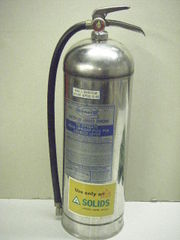
Water
Cools burning material.
- APW (Air pressurized water) cools burning material by absorbing heat from burning material. Effective on Class A fires, it has the advantage of being inexpensive, harmless, and relatively easy to clean up. In the United States, APW units contain 2.5 gallons (9 litres) of water in a tall, stainless steel cylinder. In Europe, they are typically mild steel lined with polyethylene, painted red, containing 6-9 litres (1.75-2.5 gallons) of water.
- Water Mist uses a fine misting nozzle to break up a stream of deionized water to the point of not conducting electricity back to the operator. Class A and C rated. It is used widely in hospitals for the reason that, unlike other clean-agent suppressants, it is harmless and non-contaminant. These extinguishers come in 1.75 and 2.5 gallon units, painted white in the United States and red in Europe.
Wet chemical and water additives
- Wet Chemical (potassium acetate, carbonate, or citrate) extinguishes the fire by forming a soapy foam blanket over the burning oil and by cooling the oil below its ignition temperature. Generally class A and K (F in Europe) only, although newer models are outfitted with misting nozzles as those used on water mist units to give these extinguishers class B and C firefighting capability.
- Wetting Agents Detergent based additives used to break the surface tension of water and improve penetration of Class A fires.
- Antifreeze Chemicals added to water to lower its freezing point to about -40 degrees Fahrenheit. Has no appreciable effect on extinguishing performance.
Clean agents and carbon dioxide
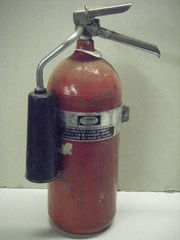
Agent displaces oxygen (CO2 or inert gases), removes heat from the combustion zone (Halotron, FE-36) or inhibits chemical chain reaction (Halons). They are labelled clean agents because they do not leave any residue after discharge which is ideal for sensitive electronics and documents.
- Halon (including Halon 1211 and Halon 1301), a gaseous agent that inhibits the chemical reaction of the fire. Classes B:C for lower weight fire extinguishers (2.3 kg ; under 9 lbs) and A:B:C for heavier weights (4.1-7.7 kg ; 9-17 lbs). Banned from new production, except for military use, as of January 1, 1994 as its properties contribute to ozone depletion and long atmospheric lifetime, usually 400 years. Halon was completely banned in Europe resulting in stockpiles being sent to the United States for reuse. Although production has been banned, the reuse is still permitted. Halon 1301 and 1211 are being replaced with new halocarbon agents which have no ozone depletion properties and low atmospheric lifetimes, but are less effective. Currently Halotron I, Halotron II, FE-36 Cleanguard and FM-200 are meant to be replacements with significantly reduced ozone depletion potential.
- CO2, a clean gaseous agent which displaces oxygen. Highest rating for 7.7 kg (20 pound) portable CO2 extinguishers is 10B:C. Not intended for Class A fires, as the high-pressure cloud of gas can scatter burning materials. CO2 is not suitable for use on fires containing their own oxygen source, metals or cooking media. Although it can be rather successful on a person on fire, its use should be avoided where possible as it can cause frostbite and is dangerous to use as it may displace the oxygen needed for breathing, causing suffocation.
- Mixtures of inert gases, including Inergen and Argonite.
- compressed CO2 sprinkler is another design used to fight the electric fires with cubic cylinder of 7 cubic meter starting from 1 meter above the sprinkler level.
Class D
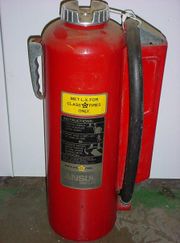
There are several Class D fire extinguisher agents available, some will handle multiple types of metals, others will not.
- Sodium Chloride (Super-D, Met-L-X or METAL.FIRE.XTNGSHR) -contains sodium chloride salt and thermoplastic additive. Plastic melts to form an oxygen-excluding crust over the metal, and the salt dissipates heat. Useful on most alkali metals including sodium and potassium, and other metals including magnesium, titanium, aluminum, and zirconium.
- Copper based (Copper Powder Navy125S) -developed by the U.S. Navy in the 70s for hard-to-control lithium and lithium-alloy fires. Powder smothers and acts as a heat sink to dissipate heat, but also forms a copper-lithium alloy on the surface which is non-combustible and cuts off the oxygen supply. Will cling to a vertical surface-lithium only.
- Graphite based (G-Plus, G-1, Lith-X, Pyromet or METAL.FIRE.XTNGSHR) -contains dry graphite that smothers burning metals. First type developed, designed for magnesium, works on other metals as well. Unlike sodium chloride powder extinguishers, the graphite powder fire extinguishers can be used on very hot burning metal fires such as lithium, but unlike copper powder extinguishers will not stick to and extinguish flowing or vertical lithium fires. Like copper extinguishers, the graphite powder acts as a heat sink as well as smothering the metal fire.
- Sodium carbonate based (Na-X)-used where stainless steel piping and equipment could be damaged by sodium chloride based agents to control sodium, potassium, and sodium-potassium alloy fires. Limited use on other metals. Smothers and forms a crust.
- Some water based suppressants may be used on certain class D fires, such as burning titanium and magnesium. Examples include the Fire Blockade and FireAde brands of suppressant.[13][14] Some metals, such as elemental Lithium, will react explosively with water, therefore water-based chemicals should never be used on such fires due to the possibility of a violent reaction.
Most Class D extinguishers will have a special low velocity nozzle or discharge wand to gently apply the agent in large volumes to avoid disrupting any finely divided burning materials. Agents are also available in bulk and can be applied with a scoop or shovel.
Fire Extinguishing Ball
Several modern ball or "grenade" style extinguishers are on the market. They are manually operated by rolling or throwing into a fire. The modern version of the ball will self destruct once in contact with flame, dispersing a cloud of ABC dry chemical powder over the fire which extinguishes the flame. The coverage area is about 5 square meters. One benefit of this type is that it may be used for passive suppression. The ball can be placed in a fire prone area and will deploy automatically if a fire develops, being triggered by heat. Most modern extinguishers of this type are designed to make a loud noise upon deployment.[15]
This technology is not new, however. In the 1800s, glass fire grenades filled with suppressant liquids were popular. These glass fire grenade bottles are sought by collectors.[16] Some later brands, such as Red Comet, were designed for passive operation, and included a special holder with a spring loaded trigger that would break the glass ball when a fusible link melted. As was typical of this era, some glass extinguishers contained the toxic carbon tetrachloride.
Maintenance
Most countries in the world require regular fire extinguisher maintenance by a competent person to operate safely and effectively, as part of fire safety legislation. Lack of maintenance can lead to an extinguisher not discharging when required, or rupturing when pressurized. Deaths have occurred, even in recent times, from corroded extinguishers exploding.
There is no all-encompassing fire code in the United States. Generally, most municipalities (by adoption of the International Fire Code) require inspections every 30 days to ensure the unit is pressurized and unobstructed (done by an employee of the facility) and an annual inspection by a qualified technician. Hydrostatic pressure testing for all types of extinguishers is also required, generally every five years for water and CO2 models up to every 12 years for dry chemical models.
Recently the National Fire Protection Association and ICC voted to allow for the elimination of the 30 day inspection requirement so long as the fire extinguisher is monitored electronically. According to NFPA, the system must provide record keeping in the form of an electronic event log at the control panel. The system must also constantly monitor an extinguisher’s physical presence, internal pressure and whether an obstruction exists that could prevent ready access. In the event that any of the above conditions are found, the system must send an alert to officials so they can immediately rectify the situation. Electronic monitoring can be wired or wireless.
In the UK, three types of maintenance are required:
- Basic Service: All types of extinguisher require a basic inspection annually to check weight, correct pressure (using a special tool, not just looking at the gauge) and for signs of damage or corrosion, cartridge extinguishers are opened up for internal inspection & check weighing of the cartridge, labels are checked for legibility, where possible dip tubes, hoses and mechanisms checked for clear free operation.
- Extended Service: Water, Wet Chemical, Foam & Powder extinguishers require every five years a more detailed examination including a test discharge of the extinguisher and recharging- on stored pressure extinguishers this is the only opportunity to internally inspect for damage/corrosion. By recharging fresh agent is used as they all have a shelf life, even water goes foul inside an extinguisher; Note: extinguishers should be percentage tested according to total number of units in any given area. Some extinguishers contain pressure in excess of 1.38 MPa (200psi) and this internal pressure over periods of time affects each brand & make differently depending on their placement & location.
- Overhaul: CO2 extinguishers, due to their high operating pressure, are subject to pressure vessel safety legislation and must be hydraulic pressure tested, inspected internally & externally and date stamped every 10 years. As it cannot be pressure tested a new valve is also fitted. If replacing any part of the extinguisher (valve, horn, etc.) with a part from another manufacturer then the extinguisher will lose its fire rating. This may invalidate insurance, as would incorrect or inadequate servicing if it were to be found.
In the United States there are 3 types of service as well:
- Maintenance Inspection: All types, annually (with the exception of water types which require a yearly recharge), consists of a physical maintenance and visual inspection. The extinguisher is checked to make sure it has good pressure (gauge in green or proper cartridge weight), has the correct volume of agent (tech weighs it), is within the required hydrotest and internal maintenance intervals, is in good condition and all external parts are serviceable. Dry chemical and dry powder types are hit on the bottom with a rubber mallet to make sure the powder is free-flowing, which is called "fluffing" the powder. The tech will then attach a new tamper seal around the pin and a yearly service tag.
- Internal Maintenance: Water-annually, foam-every 3 years, wet chemical and CO2, every 5 years, dry chemical, dry powder, halon and clean agents, 6 years.
The extinguisher is emptied of its chemical and pressure to check for proper operation. All components are disassembled, inspected, cleaned, lubricated, or replaced if defective. Liquid agents are replaced at this time, dry agents may be re-used if in good condition, halon is recovered and re-used, but CO2 is discharged into the atmosphere. The extinguisher is then re-filled and recharged, after a "verification of service" collar is placed around the cylinder neck. It is impossible to properly install or remove a collar without depressurizing the extinguisher. Note: Cartridge-operated extinguishers should be visually examined, but do not require a verification of service collar.
- Hydrostatic testing: Water, Foam, Wet chemical, and CO2, every 5 years. Dry chemical, dry powder, halon, and clean agents, every 12 years.
Extinguishers installed on vehicles every 5 years regardless of type.
Note: these are the required intervals for normal service conditions, if the extinguisher has been exposed to excessive heat, vibration, or mechanical damage it may need to be tested sooner.
The agent is emptied and depressurized and the valve is removed. After a thorough internal and external visual inspection, the cylinder is filled with water, placed inside a safety cage, and pressurized to the specified test pressure (varies with the type, age, and cylinder material) for the specified time period. If no failure, bulges, or leaks are detected, the cylinder passes. The cylinder is then emptied of water and thoroughly dried. CO2 types have the test date, company's ID, etc. stamped on the cylinder, all other types get a sticker on the back of the cylinder. Once dry, the units are recharged. Unlike the UK, the US does not rebuild extinguishers and replace valves at specific intervals unless parts are found to be defective, with the exception of halon. Halon types are often given new o-rings and valve stems at every internal maintenance to minimize any leakage potential.
OEM equipment must be used for replacement parts for the extinguisher to maintain its UL rating. If parts are unavailable, replacement is recommended, keep in mind extinguishers have a projected service life of about 25–35 years, although many are of such quality that they can outlast this, but realize that science is ever-changing, and something that was the best available 30 years ago may not be acceptable for modern fire protection needs.
Vandalism and extinguisher protection
Fire extinguishers can be a target of vandalism in schools and other open spaces. Extinguishers can be partially or fully discharged by a vandal, impairing the extinguisher's actual firefighting abilities.
In open public spaces, extinguishers are ideally kept inside cabinets that have glass that must be broken to access the extinguisher, or which emit an alarm siren that cannot be shut off without a key, to alert people the extinguisher has been handled by an unauthorized person when a fire is not present.
Fire extinguisher signs
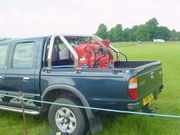
Fire extinguisher identification signs are small signs designed to be mounted near a fire extinguisher, in order to draw attention to the extinguisher's location (Ex. If the Extinguisher is on a large pole the sign would generally be at the top of the pole so it can be seen from a distance) Such signs may be manufactured from a variety of materials, commonly self-adhesive vinyl, rigid PVC and aluminum.
In addition to words and pictographs indicating the presence of a fire extinguisher , some modern extinguisher ID signs also describe the extinguishing agent in the unit, and summarize the types of fire on which it may safely be used.
Some public and government buildings are often required, by local legal codes, to provide an ID sign for each extinguisher on the site.[17]
Similar signs are available for other fire equipment (including fire blankets and fire hose reels/racks), and for other emergency equipment (such as first aid kits).
Placement of fire extinguisher signs
Fire extinguisher signs are mounted above or to the side of the extinguisher they relate to.
Most licensing authorities have regulations describing the standard appearance of these signs (e.g. text height, pictographs used and so on).[18]
Photo-luminescent fire extinguisher signs
Photo-luminescent fire extinguisher signs are made with a photoluminescent phosphor that absorbs ambient light and releases it slowly in dark conditions - the sign "glows in the dark". Such signs are independent of an external power supply, and so offer a low-cost, reliable means of indicating the position of emergency equipment in dark or smoky conditions.
Photo-luminescent signs are sometimes wrongfully described as being reflective. A reflective material will only return ambient light for as long as the light source is supplied, rather than storing energy and releasing it over a period of time. However, many fire extinguishers and extinguisher mounting posts have strips of retroreflective adhesive tape placed on them to facilitate their location in situations where only emergency lighting or flashlights are available.
References
- ↑ The United States Patent and Trademark Office * Volume 192 - September 15, 1881
- ↑ "Staffordshire Past Track -"Petrolex" half gallon fire extinguisher". http://www.search.staffspasttrack.org.uk/engine/resource/default.asp?resource=14547. Retrieved 2009-05-25.
- ↑ Loran and the fire extinguisher at p-lab.org (Russian)
- ↑ U.S. Patent 1,010,870, filed April 5, 1910.
- ↑ U.S. Patent 1,105,263, filed Jan 7, 1911.
- ↑ "Pyrene Fire Extinguishers". Vintage Fire Extinguishers. http://www.vintagefe.com/pyrene.html. Retrieved 23 December 2009.
- ↑ "Carbon Tetrachloride Health and Safety Guide". IPCS International Programme on Chemical Safety. http://www.inchem.org/documents/hsg/hsg/hsg108.htm. Retrieved 25 December 2009.
- ↑ McCarthy, Robert E (1992-06-18). Secrets of Hollywood special effects - Google Books. ISBN 9780240801087. http://books.google.com/?id=B4applRToVQC&pg=PA149&lpg=PA149&dq=CO2+extinguisher+stunt&q=. Retrieved 2010-03-17.
- ↑ "Halon Disposal". Ozone Protection. Australian Government Department of the Environment and Heritage (Australia). http://www.deh.gov.au/atmosphere/ozone/ods/halon/disposal.html. Retrieved 2006-12-12.
- ↑ firesafe.org.uk
- ↑ 11.0 11.1 11.2 "The Fire Safety Advice Centre". http://www.firesafe.org.uk/html/fsequip/exting.htm.
- ↑ Wasserfilmbildendes Schaummittel - Extensid AFFFPDF 071027 intersales.info
- ↑ "Fireade 2000 Applications". http://www.firesupplydepot.com/fireade-applications.html. Retrieved 2009-11-10.
- ↑ Fire Blockade Pro - Industrial Products
- ↑ Chuck a ball to put out fire. Earth Times. 14 September 2007. http://www.earthtimes.org/articles/show/107481.html.
- ↑ firegrenade.com
- ↑ CAIS16 - Safety signs in the catering industry
- ↑ Transport for London
- Automatic Sprinkler Protection - Goram Dana, S.B.
External links
- Underwriters Laboratories tips
- MSDS Sheets for hand held portable fire extinguishers
- OSHA requirements
- Online museum about antique fire extinguishers and their history
- Fire Extinguisher Information Site
- National Fire Help
- Fire and Safety Equipment Inspections
- How to use a fire extinguisher
- Aviation requirements for fire extinguishers
- Fire extinguisher inspection and maintenance requirements
- Fire extinguisher training video
- Fire extinguisher training Web site
- Fire Equipment Manufacturers' Association
- Advise and guidance on extinguisher locations/types and legislation
- South African Marine Requirements for fire extinguishers or inhibitors
|
|||||||||||||
|
|||||||||||||||||
